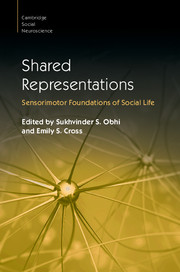Book contents
- Shared Representations
- Cambridge Social Neuroscience
- Shared Representations
- Copyright page
- Contents
- Figures
- Tables
- Boxes
- Contributors
- Preface
- Part I Foundations
- Part II Imitation and Mimicry
- Part III Thinking, Perceiving and Acting with Others
- Part IV Understanding Others
- 15 The Social Function of the Human Mirror System
- 16 Biological Tuning of Mirror Mechanisms
- 17 Representation of Self versus Others’ Actions
- 18 Reading Intention in Action
- 19 Complementary Actions
- 20 Emotional Convergence
- Part V Learning and Development
- Part VI Shared Representations in Applied Contexts
- Index
- Plate Section (PDF Only)
- References
18 - Reading Intention in Action
from Part IV - Understanding Others
Published online by Cambridge University Press: 27 October 2016
- Shared Representations
- Cambridge Social Neuroscience
- Shared Representations
- Copyright page
- Contents
- Figures
- Tables
- Boxes
- Contributors
- Preface
- Part I Foundations
- Part II Imitation and Mimicry
- Part III Thinking, Perceiving and Acting with Others
- Part IV Understanding Others
- 15 The Social Function of the Human Mirror System
- 16 Biological Tuning of Mirror Mechanisms
- 17 Representation of Self versus Others’ Actions
- 18 Reading Intention in Action
- 19 Complementary Actions
- 20 Emotional Convergence
- Part V Learning and Development
- Part VI Shared Representations in Applied Contexts
- Index
- Plate Section (PDF Only)
- References
Summary
The human ability to predict and interpret others’ intentions is crucial to social life. The purpose of this chapter is to consider the proposition that intentions can be understood from observing others’ movements. To this end, we first focus on experimental evidence showing that individual, social and communicative intentions ‘shape’ movement kinematics. Next, we review recent work suggesting that during action observation humans are capable of picking up intention information and using it to predict others’ behavior. In the third section, we address the neural mechanisms that mediate the ability to read intention from movement observation. Based on preliminary data, we argue that mirror neuron areas are sensitive to intention information conveyed by movement kinematics. Finally, we discuss the hypothesis that a deficit in this ability might account for the difficulties in social interaction reported in autism spectrum disorders.
- Type
- Chapter
- Information
- Shared RepresentationsSensorimotor Foundations of Social Life, pp. 374 - 391Publisher: Cambridge University PressPrint publication year: 2016



